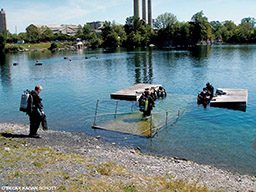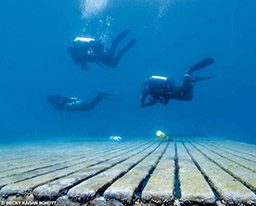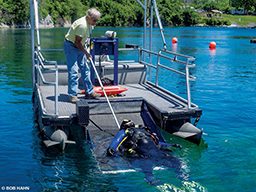Dutch Springs, a 50-acre lake in Bethlehem, Pa., boasts the largest number of dives logged in the United States every year. More than 30,000 divers visit during the facility’s eight-month season, so it’s possible for hundreds of divers to be in the water at any given time. For many years the facility used an inflatable rubber rowboat for diver rescues. This seemed to be the best solution for limiting potential contamination of the clear lake water as well as ensuring the safety of divers on the surface. This solution, however, also made for a slow rescue and a tired rescuer.

Many alternatives were proposed over the years, but in 2012 the management and lake safety staff made a concerted effort to improve the efficiency of diver rescue while maintaining the safety of others in the water and the quality of the environment they enjoy. Many hours of brainstorming led to even more hours of experimentation with a variety of vessels. A group of lake safety staff evaluated every type of small boat available, including personal watercraft with sleds, flat-bottom boats with outboard motors and inflatables with cutouts in the floor for diver extraction. The staff and management ultimately decided to use a small, shallow-draft pontoon boat with a shrouded, battery-powered electric drive mounted inboard of the pontoons. This platform would provide the best combination of maneuverability and stability while maintaining a low submerged profile and a nonpolluting drive system.
One persistent problem was the challenge of moving an injured diver in full gear from the water into the boat with a single rescuer. While on vacation one of the lake safety staff, Dave Gregor, observed a ferry boat with a drop-down ramp for cars to drive onto and off of. At that moment a breakthrough in diver recovery occurred. An engineering technologist, Gregor envisioned an elevating ramp located in between the pontoons at the bow of the boat. Additionally there would be a remote control that could be operated by the rescuer while he or she drove the boat. The rescue plan Gregor conceived would allow the operator to single-handedly approach, collect and deliver the injured diver to shore. But no manufacturer offered such a boat.

In 2013 Dutch Springs located and purchased a well-used pontoon boat. With this vessel as a starting point, a construction team of Gregor, Ron Siedlecki and Kevin Scott designed a smaller boat with all of the desired features. Over the course of a year, the team disassembled the original vessel, cut down its pontoons from 20 feet to 12 feet, fabricated a new frame and reassembled the boat. They acquired and installed a drive system with solar panels to charge the batteries, eliminating the need for shore power.
The ramp system features a hinged aluminum frame with a carpeted fiberglass grate deck. The ramp is lowered and raised with a series of cables and pulleys driven by a reversible electric motor that has a battery and charging system separate from the boat’s drive system. The operator station is a center console with wheel steering and speed, direction and ramp controls at the operator’s fingertips. A grab rope system is attached outboard of each pontoon for assisting tired divers.
After lake safety staff underwent extensive training that included operation, rescue technique and maintenance, the Daros was placed in service at the opening of the 2015 dive season. The name represents the names of the builders, Dave and Ron, and Dutch Springs owner Stu Schooley.

There is room on the boat for the rescuer and a staff emergency medical technician (EMT). During busy periods, the boat is moored in the middle of the lake and serves as a central lookout station, manned by one of the lake safety staff. The EMT is posted at one of the lake’s three shore-based lookout stations to handle any emergencies that arise at the facility.
In a typical rescue, the operator will make a controlled approach with the ramp lowered to a level just below the injured diver on the surface. The operator will stop the boat and guide the fully geared diver onto the submerged ramp using an extended boat pole. The operator then raises the ramp out of the water while heading back to the dock. The dock is another custom design; it includes an opening that mates to the ramp on the boat. The opening engages the ramp as the boat approaches and provides a secure platform for the waiting lake safety and medical staff to attend to the injured diver.
To date, the Daros has been used successfully to assist divers as well as patrons of the adjacent Aqua Park and continues to be one of the many measures Dutch Springs employs to enhance the safety of its guests.
© Alert Diver — Q3 Summer 2016